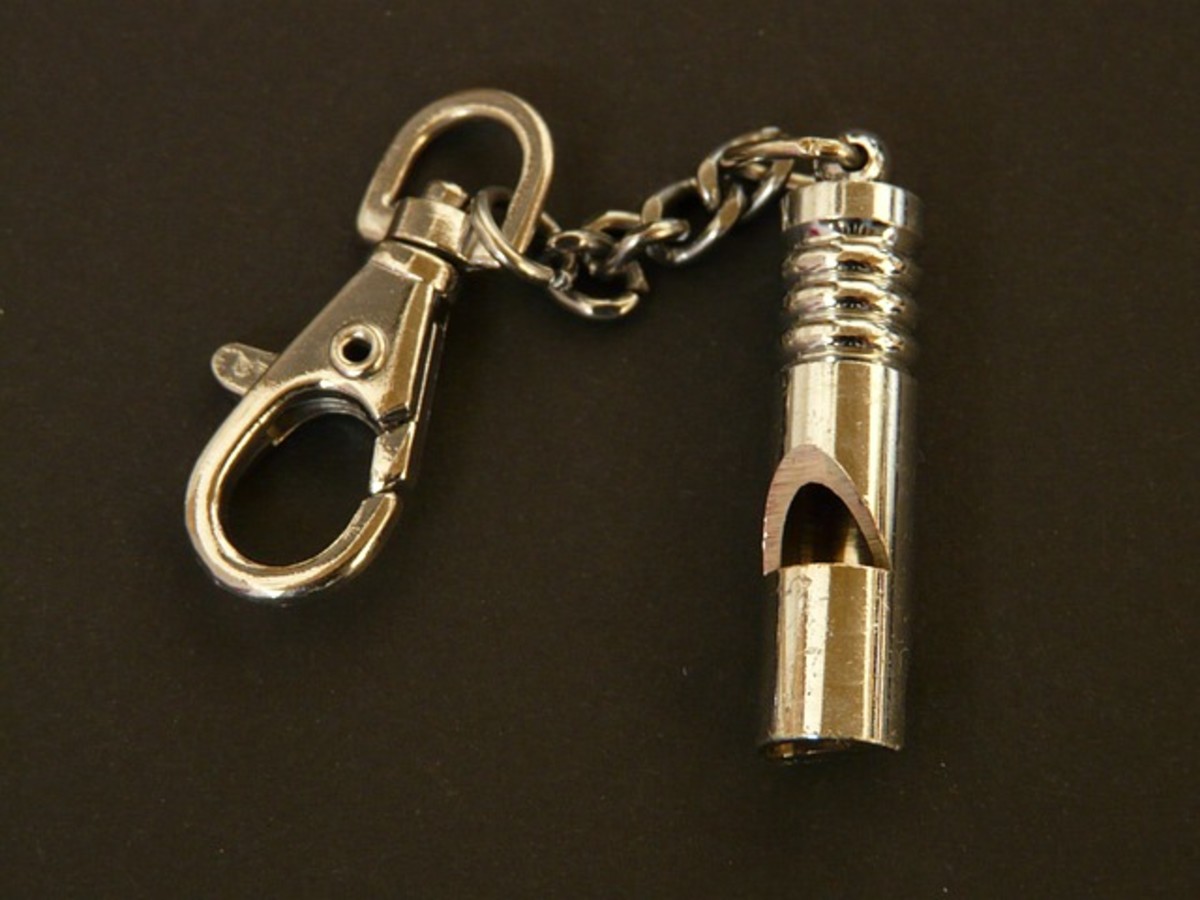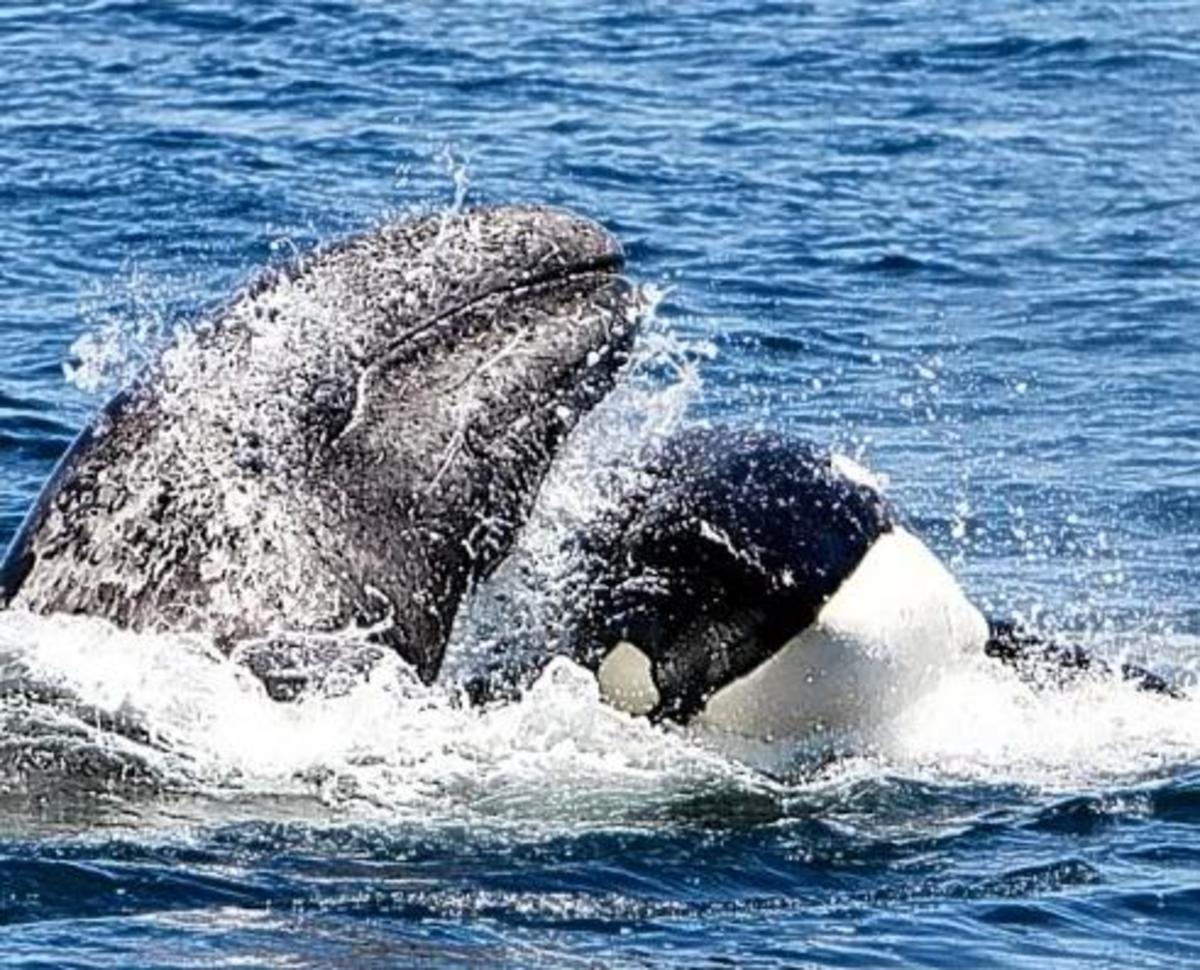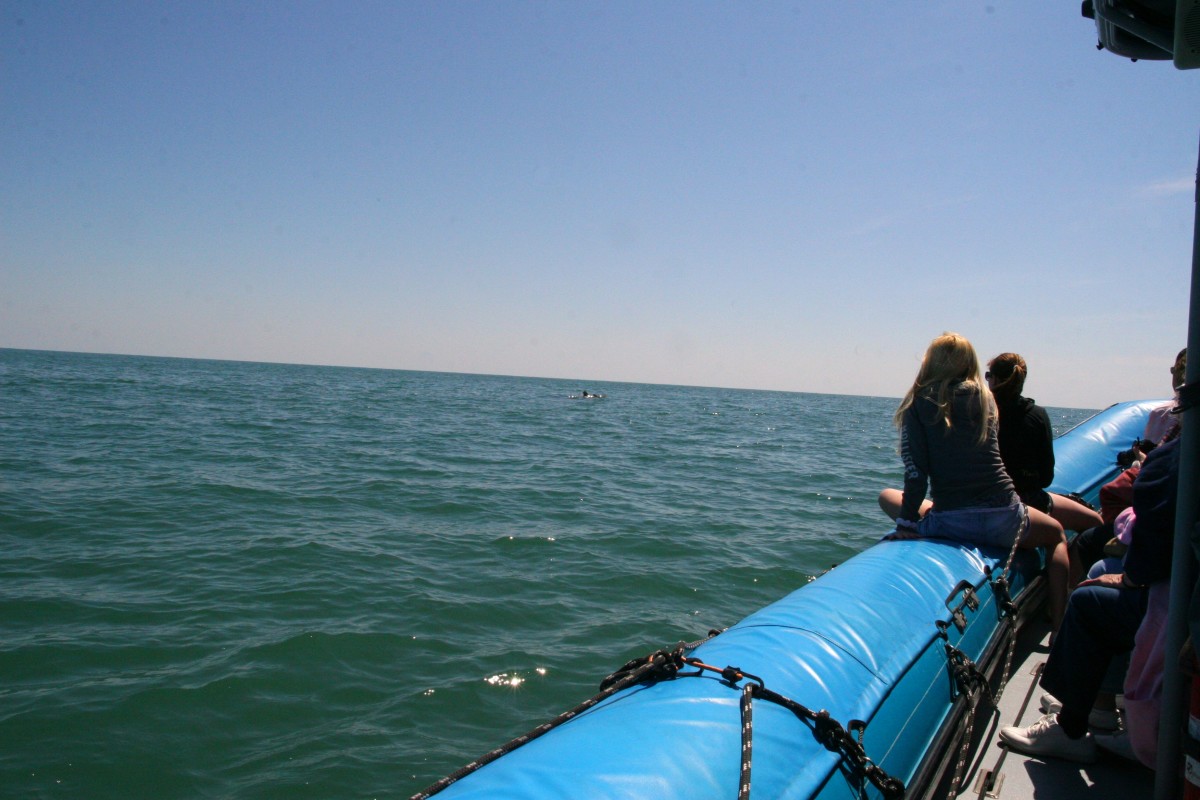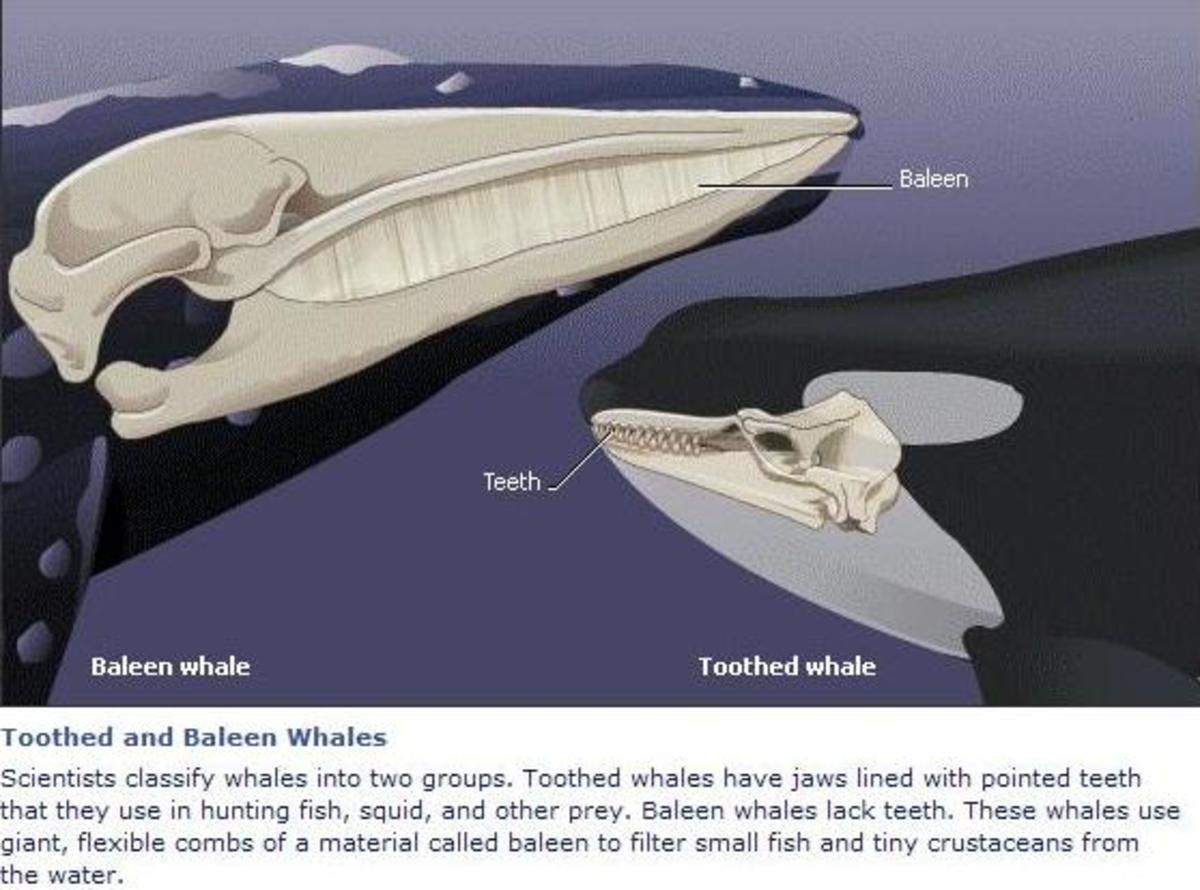- HubPages»
- Education and Science»
- Life Sciences»
- Marine Biology»
- Marine Life
Reviewing the Signature Whistle Hypothesis in Bottlenose Dolphins, Tursiops truncatus
Flipper was instantly famous for his squeaky yip yip that signaled trouble or delight to his human friends. In 1964, for the first time in mass media, dolphins were introduced as having intelligence on par with human beings which set a new standard for animal behavioral and physiological research. Partly due to this representation, the bottlenose dolphin, or Tursiops truncatus, (referred to henceforth as both bottlenose dolphin and dolphin) has become the topic of numerous hypotheses as to their intelligence and capabilities. Also, research has defined that each bottlenose dolphin has a characteristic signature whistle, or vocalization, with which they can be identified and use as a form of group cohesion and continuity.
The purpose of this discussion will be to take a close look into the signature whistle of the T. truncatus which will include a definition of the signature whistle hypothesis, the basics of the bottlenose dolphin social group, communication within a social group, psychological ability for abstract thought, and whistle acquisition, usage, and matching best synthesize the purpose and function behind bottlenose dolphin communication.
The Signature Whistle Hypothesis
The signature whistle hypothesis. Researchers take a close look at a group of bottlenose dolphins (either in captivity or in the wild), record their vocalizations over a period of time, and state their theories about what the vocalizations within a group of dolphins might mean. The theory itself states that each bottlenose dolphin produces a characteristic whistle, known as their signature whistle, that acts as their identifier, or name, to others dolphins. In turn, other dolphins mimic this signature whistle to communicate directly with a single dolphin.
Many researchers also spend much of their work determining how the signature whistle is acquired by individual dolphins, if they get cues from familial ties or if they act independently during acquisition. Finally, research is spent on the purpose of a dolphin’s signature whistle and why it might be a necessary form of communication within a social group. Thus, to fully define the necessity of the signature whistle and the formation of this hypothesis, a close look will first be taken into dolphin communication and social groups.
Dolphin Communication
Dolphin communication is comprised of a series of whistle-like sounds, or squeaks. Much of the noise has been recorded as direct communication within the group, though there is differentiation in terms of signature whistle usage, brays, and echolocation. Signature whistles are used primarily to communicate directly with a single dolphin; however brays and echolocation serve the group dynamic on the whole. Bottlenose dolphins have been recorded using brays mainly for the purpose of foraging or hunting, while they use echolocation to determine group position, hazards, and necessity for group defense or movement. This will be detailed later, but for the purpose of the discussion now, it is useful in understanding how communication works within the social group dynamic.
Dolphin Social Group Definitions
In the wild, bottlenose dolphins generally form groups of twenty or less which is made up of alpha animals, animals who serve as lookouts or guards, and animals that stay primarily within the core of the group, which are usually the calves or the females. The group is intensely protective of their females and young, even going so far as to outright challenge other dolphin groups that stray to close. Often, other dolphin groups will attempt to steal females from other groups, which is the primary function behind the protective group dynamic. This group dynamic is often referred to as a social group or alliance within much of the research.
At other times, researchers refer to the group dynamic as a fission-fusion society. In the past, the term “fission-fusion society” has almost always referred to the study of primates, but in this sense refers to a group cohesion when it comes to foraging and hunting. For example, the dolphin group sleeps together, but will separate into smaller groups, which separate into different directions, to forage or hunt. The main group will split (or fission) during the day to accomplish tasks, while they will reform (fusion) during the night for protection and to return to the group dynamic.
Communicational Aspects of Social Groups
The fission-fusion society plays a large role in the communication aspects of dolphin social groups, but that role was never fully understood until bottlenose dolphins were observed in a captive setting when in 1992, Connor et al. studied a group of captive bottlenose dolphins in Shark Bay, Western Australia. Prior to this study, researchers were unable to find the connection between communication and the dolphin social group because the noise recorded was inconclusive. Perhaps technology was a hindrance, in either case Connor et al. was clear in stating that communication between a group dynamic was only understood once the dolphins were in self-contained captivity. From this research, Connor et al. concluded that dolphins were capable of social interactions within a group setting and have been seen performing actions within an alliance.
An alliance, in this sense, means that they were seen acting with knowledge of the others, performing actions in synchronicity, and even acting to the benefit of other dolphins. Viewing the dolphins acting in this manner was profoundly significant to the researchers, who had in the past believed that only humans and primates held the capacity to act in such a way. More, for the first time, a study was able to categorize what they were seeing as a social network among the bottlenose dolphins, which allowed for precise understanding and categorization of behavior which included their own social standing within the group environment, and differentiation between individuals within the group setting. The Connor et al. study identified that certain individuals held more power within the group by the deference shown to them from others, that other dolphins always acted on the perimeter of the group, almost as guards, and that certain individuals were always protected—namely the females.
Furthermore, Connor et al. identified that bottlenose dolphins form a fission-fusion society in which members of the social network are often foraging and feeding outside the confines of the group dynamic. This information sparks the idea that bottlenose dolphins are capable of maintaining the group conversation while members of the group are some distance away. The fission-fusion society functioned when members of the group split from the main group to perform hunting or foraging duties, at which point they would return to the main group.
A later study by Reiss et al. (1997) reviewed the trends in fission-fusion alliances and social groups to determine the cognitive characteristics of the bottlenose dolphin. The fission-fusion society is essentially one of complex social and individualized interactions, much like those seen in a primate or human society. Essentially, this determines whether or not dolphins are aware of the others in a learned environment, whether there is regard for alpha dolphins (or elder dolphins) and how others interact within the group as a whole. Reiss et al. was quick to point out that dolphins are the only other mammal, aside from humans and primates, who have the ability for vocal learning and psychological and symbolic understanding and development. Primates, as is now understood, have the ability to learn sign language and communicate directly with their trainers. They have also been studied teaching other primates sign language, and they often interact with objects or symbols to communicate fully. Dolphins, too, share this ability. Though they are incapable of physically signing or speaking a language, by use of whistles in training sessions, dolphins can be made to understand what is required of them. In turn, the Reiss et al. study found that dolphins communicated directly with their trainers in order to get what they wanted. Certain whistles were determined to mean “I’m hungry” or “I don’t want to train anymore.” The study also determined individualized sounds for playfulness or times at which the dolphin was tired and wanted to rest.
The Reiss et al. study defines a complexity for auditory learning and tasks that require memory (such as being employed in a military situation or entertainment event) and having to perform tasks on a standardized basis without step by step instruction every time. This sophisticated level of communication provides for both abstract thought and internalized reasoning which wasn’t believed to be part of the dolphin intelligence. Next, a look will be taken into what this sophisticated level of communication means for complex and abstract thought.
Psychological Ability for Complex and Abstract Thought
When humans look into a mirror, even as young children (occurring around 18-24 months), they understand psychologically that they are viewing themselves—it is a level of self-awareness that most mammals do not possess. A study by Reiss & Marino (2001) concluded that primates also have this innate psychological ability for self-awareness and comprehension. Basically, this ability for recognition is tied directly to the human’s or primate’s capacity for abstract thought and self-awareness. In the Reiss & Marino study, a thirteen-year old bottlenose dolphin, born in captivity, was placed in an aquarium with a glass panel separating him from another captive-born bottlenose dolphin of seventeen years. The purpose of the containment was to analyze whether or not the two dolphins were able to view the other dolphin and understand that it was, indeed, another dolphin on the other side of the glass.
Finally, a mirror was placed at the far end of each tank to allow the dolphins to view themselves while they acted in synchronicity with the other dolphin. The test had both dolphins completing a set of tasks identical to the other for a period of four years in order to bring them to the glass and over to their mirror in synchronicity and note the results. The idea was to determine whether or not the dolphins were aware when they were viewing themselves in the mirror, or if they understood when they were viewing the other dolphin, even though the actions were entirely identical. In the end, Reiss & Marino found that both dolphins attained a level of self-awareness and would often spend more time viewing themselves in the mirror’s reflective surface, despite the forced behavioral drills. Further, findings showed that the bottlenose dolphins spent little to no time displaying social behavior (cooing noises, whistles, or waving with their fin) towards the mirror, but would often exhibit social responses to the bottlenose dolphin behind the glass surface, even when acting in tandem.
Additionally, Connor et al. (1992) found that bottlenose dolphin communication serves many functions, from allowing male members of a group dynamic to swim behind or near female members to mark their location (to keep the females in check) to other members of the group as well as enabling cooperative herding of females who might spook in dangerous situations and swim away from the group’s safety and protection. This specific function of communication also allows for alerting the main group when danger to the alliance is imminent. In the study, Connor et al. found that male bottlenose dolphins might choose to steal females (as theft is common and females rarely fight their abductor) from another alliance. In nearly all instances, members of both alliances were alerted to the theft and were immediately summoned to participate in the fight.
Communication within the social group also extends to other aspects of hunting or foraging behavior. Krutzen et al. (2005) sought to explain the bottlenose dolphin social group of Shark Bay as to their use of marine sponges as foraging tools in relation to the way in which primates use tools for foraging. This behavior was classified among the wild bottlenose dolphins which suggests a culture and learned behavioral aspect never previously defined. More, in both the wild and captive-born, dolphins have shown remarkable ability for imitation and social learning which demonstrates a genetic capacity for material culture and social tradition. Thus, while dolphins in captivity have the capacity for learned behavior as well, the ability for those in the wild to exhibit functional tool-usage suggests that the behavior is part of a deeper inset in the dolphin’s ability for learned behavior than has been previously believed.
Another aspect to abstract reasoning capabilities is suggested by the whistle sounds that are often differentiated by the task at hand. Janik (2000a) found that a group of dolphins in the Moray Firth, Scotland area produce a specific sounding whistle, or bray, when engaged in the particular act of hunting salmonids. This sound is similar to the foraging and tool-utilizing behavior in that the sound of the whistle itself works as a homing beacon for the salmonids with the ability for prey manipulation and debilitation. This particular study identifies that the dolphins are able to exploit the perceptual systems of their prey in order to make a kill. As Janik discovered, the bottlenose dolphin’s unique ability allows for prey debilitation provided by a whistle series that sounds like low-frequency bangs and chirps. Janik’s study recorded the passive acoustic location (marking each dolphin’s location based upon their individual whistles) of each individual animal to determine, from the surface, when wild dolphins were engaged in prey debilitation and found that the use of brays was consistent with their hunting of salmonids.
Captive animals do not seem to have this same ability, however, as this particular bray has never been taped or seen. The reason for this, as Janik suggests, could be that captive dolphins receive dead fish and have no need for prey debilitation or capture techniques as it has also been recorded among other wild populations. It also suggests that captive dolphins might have a differentiated ability for other skill sets such as echolocation, which might have an impact on the brain size and development of captive animals versus those found in the wild.
After this, a study by Huggenberger (2008) set out to determine the encephalization level of dolphins in comparison to other primates and human beings. The study states that dolphins have a similar brain to body evolution and development which suggests higher levels of intelligence and reasoning faculties. While the functional implications of bran size are still in the first stages of testing and hypothesis, early results showed that the auditory structures in the bottlenose dolphin are large for a mammalian species which may be the primary reason for larger brains. Larger brains, paired with the auditory structures, allows for the dolphin to communicate underwater with speed and clarity. Larger brains would also explain the dolphin’s higher level of communication abilities and thought processes.
Based upon previous research, Huggenberger argued that dolphins have evolved for greater computation performance than other land and air mammals due to the need for rapid and intelligent communication within and away from the group dynamic.
Whistle Acquisition and Usage within a Social Group
In young bottlenose dolphins, whistle acquisition, even that of the signature whistle, is a learned behavior. A study by Fripp et al. (2005) reviewed a group of young calves in varying environments and social situations to determine the vocal learning and development of the signature whistle. The study utilized frequency contours (the sounds of individualized frequencies over a period of time) to dynamically chart the development of each calves’ whistle acquisition in comparison to their own social group, other captive dolphins, and a social group of Tampa Bay dolphins. The similarities between social groups was the most significant, with the authors noting that the calves categorically modeled their signature whistles upon those who were directly within their own social community. If the calves’ mother was present within the group, the calf nearly always demonstrated a similar signature whistle and frequency to that of the parent.
Vocal learning, in this sense, is closely related to that of humans. Consider children raised in different parts of the country. Children learn their vocal cues from the adults in their own community and, without even intending so, imitate the sounds and dialect of their elders. A child from the South will undoubtedly have a different accent than a child raised in California even though they are speaking the same language. This form of vocal learning and comprehension is directly relational to that of bottlenose dolphins. As Fripp et al. (2005) discovered, calves from different social groups regularly retained different frequencies, or dialects, in the development of their signature whistle.
However, there has been some speculation as to the whistle acquisition and usage of captive dolphins. As suggested by Sayigh et al. (2007), in reviewing the data sets from a study completed by McCowan & Reiss, 2001, captive dolphins failed on the order of nine out of twelve times to produce a signature whistle while in seclusion or within a group dynamic. McCowan & Reiss suggested that previous studies used biased results and data sets to create a visual classification that fails when compared to computerized techniques and analysis of the same data sets. Sayigh et al. took this conclusion and set up a new technique to evaluate the accuracy of either claim.
Sayigh et al.’s study focused on twenty randomly selected whistles from a group of twenty captive dolphins in Sarasota Bay, FL to determine the group similarities based visually upon an analysis of the whistle contours. On an order of 18.9 plus or minus 1.6 out of twenty captive dolphins performed signature whistles in both the group and solitary dynamic. The results completely debunked the claims made by McCowan & Reiss six years previous. The results also found that the whistles performed by dolphins within a group dynamic were performed nearly simultaneously which suggests a new level to the vocal repertoires of the bottlenose dolphin’s communicational aspects.
More than ten years pervious, Sayigh et al. (1998) performed a series of studies to determine whether the whistle of an individual dolphin contains enough identifying information to be used in such a manner. This study set the grounds for the 2007 study which conclusively identified from the group of twenty captive dolphins that each individual had a distinctive whistle which allowed for communication within the group dynamic. As things stood in 1998, research found that mother dolphins reacted more strongly to the whistle of their own offspring than the offspring of other mothers, even though all offspring were of the same age and were cared for in the group as a community of family and parents.
From this information, Harley (2008) started a new study which determined whistle discrimination and categorization by a female Atlantic bottlenose dolphin to review the dimensions of the signature whistle in a perceptual test. The test itself operated by stimulating the dolphin with taped signature whistles of other dolphins from her original group and other dolphins outside her group to determine her level of discrimination and self-awareness of her own group dynamic. The perceptual test for mapping the dolphin’s response was based upon the frequency contour of each signature whistle, which is a charting of the whistle’s change in frequency over a period of time. Results were categorically conclusive, determining that the female dolphin responded with a level of discrimination based upon contour rather than voice cues, and always reacted socially to sounds from her own social group.
Essentially, the Harley study breaks down to an analysis and classification of the bottlenose dolphin’s ability for acoustic production and reception. Their whistles are inherently broadband echolocation (a series of clicks and burst pulses) and narrowband whistles which have both environmental and social uses within a group dynamic. Echolocation serves to locate the group within a larger area, to notify of events or other animals, and to keep in contact with individuals while away from the social dynamic. As Harley found, the narrowband whistles are lower in frequency than signature whistles or echolocation pulses which serve the purpose of contact calling to other dolphins—or specific conversations to specific individuals.
Even more, Harley researched a previous study that recorded a group of dolphins and the change in their whistle frequency and contours over a period of time. It was found that each individual dolphin produced both a signature whistle and a signature frequency on the overall contour. Later, this research was utilized by Quick & Janik (2008) who found that the whistle rates of individual bottlenose dolphins changed in relation to group size and context. Overall, it was found that dolphins were more likely to produce whistles when the group dynamic was more scattered, and less likely to conversate at a higher degree of whistle rates while in a tight group formation. While in group formation, whistles served the main function of group maintenance and marking the position of members. While the group formation is more scattered, the need for whistles as communication grew on an exponential level to maintain the group dynamic even though the group was dispersed. The information also shows that while the group was dispersed, there were more whistles between small groups of dolphins than there were when the group was together in a larger dynamic.
Furthermore, a study by Cook et al. (2004) also found that whistle production was directly related to group size and formation. In all cases, dolphins produced less whistles and signature whistles while in a larger group than they did when in solitary situations or while the group was travelling—at which point only a few lead dolphins produced whistles at all. Group dispersal played a large role in the number and frequency of whistles as well, making clear the idea that dolphins communicate more freely when in smaller groups than they do when in larger more dynamic group situations.
The Quick & Janik (2008) study also found that when a group of dolphins was dispersed in the wild, other dolphin groups were more likely to whistle, which has often been caught on tape and produced into the contour studies as an overestimation for the whistle rates of a given group. In reviewing previous studies, Quick & Janik determined that signature whistles contributed between thirty nine and fifty two percent of all the whistles heard from one group. This number goes down even more when the group becomes larger than ten. The reason may be that dolphins are using whistles in context with a situation that is, as of yet, entirely unknown.
However, the reason may be more simple than Quick & Janik are willing to admit. Humans actually function in the same way. The larger the group, the less likely an individual will speak of his own accord. Take a classroom situation for example—especially at the start of a semester. Students will retain silence until the group dynamic shifts in a way that allows for comfortable conversation between individuals. At any given moment, however, the group dynamic suggests silence (relationships have not been formed to allow free conversation) in anticipation of one main conversant, or whistle, that will be giving out important information that cannot be obtained elsewhere. In this sense, students, even outgoing individuals, will adapt silence in a group situation based upon the context of the group itself.
Whistle Repertoires
Janik (2000b) found that dolphins can imitate new sounds, with definitive accuracy, on their first attempt and can repeat that sound years later in life without additional mimicry. Matching is not an action that occurs by chance. In fact, dolphins, like humans, have different rates of learning and abilities. This allowed the study to concentrate on focused whistle sounds in larger groups to determine the rate at which whistle sharing occurred and the rate at which whistles were imitated by other dolphins.
Furthermore, Janik found that dolphins would consistently whistle match (one dolphin whistled, another imitated, followed by repeated whistle sharing) during any given period of time, consistently. Such whistle matching and sharing could indicate a variety of functions within the society, from directly addressing another dolphin to showing alliance to members within a group to dissuade rogue dolphins from entering with a copied whistle. Whistle imitation was conceptually shown to also play a large part in mating rituals, and can almost be viewed, on human terms, as a way to show affection by imitating a key phrase or nickname.
A similar study by Janik & Slater (1998) found that while individuals produced a stereotypical whistle for imitation, the usage of whistle sharing was limited contextually to one event or time. Taking this, a study by May-Collado & Wartzok (2008) defined this context as being vastly different in adjacent populations of dolphins. Adjacent groups were shown to never utilize the same whistle sounds, even varying their sound frequencies from group to group. In an attempt to define whether or not dolphins used learned whistles entirely in context, Janik & Slater studied individuals from the same group of captive dolphins that were recorded while in seclusion from the others as well as while they were within the same aquarium. Each dolphin made specific, signature whistles while separated from the group dynamic, but when the group was returned, signature whistles were used only in a shared context. Janik & Slater defined this context as the method for which the dolphins maintained their group dynamic, utilizing shared whistles only to communicate directly with one individual.
Additionally, a study by Barton (2006), illustrates that dolphins have the ability for abstract thought as well as social recognition. The frequency produced by whistle imitation allows for dolphins to have a unique rapport with the dolphin that they are communicating with. Much like the communication between two humans, dolphins have the ability for recognition of members within their social group based upon the frequency and unique sound of a signature whistle. Barton cites the formation of cognitive evolution which is supported by the brain size and capacity of the bottlenose dolphin in which he suggests that the evolution of dolphin communication comes down to a matter of their intelligence and development.
Statistical examination of the bottlenose dolphin’s whistle repertoire has always been difficult to define in a qualitative examination. In an effort to statistically categorize the bounds of the whistle repertoire, McCowan et al. (1999) conducted a study using qualitative tools to compare animal communication systems. The study itself was formed around a hypothesis and set of tools originally constructed by Zipf (1949, Human Behavior and the Principle of Least Effort) which set the standard for first-order relation entropic studies. The idea was to apply temporal statistics in determining repertoire complexity by reviewing comparative indicators. The statistical information gained highlighted the information transfer produced by a signature whistle and the potential for acquisition and learned behavior based upon the data sets which showed that the repertoire was far more complex than before imagined.
Further, McCowan et al. found that the whistle repertoires were never repetitious or unified which illustrates the idea that each whistle is intended as a single wave of diversified identifying information. Even more, different signature whistles carry a different amount of information in them. While the structural composition of each is similar in design, each held a different value of information. For example, one dolphin’s signature whistle was the equivalent of two words, while another’s was the equivalent of two sentences—though each held the same identifier qualities. If this theory is translated into how the English language is conveyed, the same theory can be applied to names and identifiers. At any given time, each person has a first, middle, and last name. Some have nicknames. Some have married names. McCowan et al. paralleled this information into the hypothesis of the signature whistle to determine that each dolphin’s whistle was their unique identifier, or name, and that some names were longer, and thus contained more information, than others.
Esch (2009) summarized the work of no less than ten academic articles on the signature whistles of bottlenose dolphins and determined that signature whistles vary by age and sex, that young dolphins or calves have higher whistle rates than their adult contemporaries, and that males decrease in whistle rate at a higher level of decline than adult females. Again, this parallels to the same rates at which human beings communicate. Human females have long been stereotyped as talking and conversating much more than males of the same age, and young children and teens have a much higher rate (and need) for conversation than their adult figures. Esch, in this, demonstrates the parallel to human nature quite well, even suggesting that a dolphin’s identity grows as they grow, until their signature whistle has been achieved.
Also, Esch (2009) pointed out that adult dolphins were more complex in their whistle usage, employing whistle loops which are related to the level of arousal in the individual’s receiving dolphin. These whistle loops are essential in the mating rituals of adult dolphins, but also illuminate a level of recognition matching that many of Esch’s contemporaries failed to mention in their own studies. An understanding of the mating rituals would perhaps shed greater light on the phenomena of whistle loops, but Esch does much to suggest that dolphins posses an awareness of the need to conversate between their peers and potential matches. The level of whistle loops are often much higher as a pair first comes together, with the whistle loops descending in frequency the longer the pair has been a mated match. This same theory is well-known in human relationships as well, and suggests that dolphins need more contact and conversation when beginning a relationship than when they have been mates for some time.
Signature Whistles and Recognition Matching
In 1994, Janik published his research on the context-specific information produced by an individual dolphin’s signature whistle. The research concluded that the signature whistle provided a mix between contextual information and information regarding an individual’s identity. Later, Janik (2000b) surveyed wild bottlenose dolphins in an attempt to define their communicational abilities in relation to the recognition of whistle matching. Captive dolphins have long shown that they can understand and perform to differentiated whistle commands, but Janik found that dolphins in the wild have the ability to share whistle interactions over a distance of more than 580 meters (or 1,900 feet), they have the ability to modify the structure of their whistle to signal different situations, and they can imitate new sounds very easily. The purpose behind whistle recognition and matching ties directly into the need for group cohesion and maintenance. As Janik et al. (2006) discovered, the bottlenose dolphins encode identity information in their signature whistles which enables the group to focus upon and communicate directly with one dolphin even if that dolphin is some distance away.
The question of whether or not wild dolphins produced the same signature whistle sets was intriguing to Watwood et al. (2004) who sought to define the rate at which bottlenose dolphins in a wild and free-swimming environment participated in signature whistles. The results found that eleven out of thirteen from within the allied group produced signature whistles and matched shared whistles 76% of the time. Further analysis of this information suggests that the wild dolphins utilized shared whistles and recognition matching in the same manner as do captive dolphins—for communication within a single allied group dynamic.
Janik’s prior study (1999) reviewed the ability for the human ear to pinpoint a signature whistle with more reliability than a computerized analysis could. The study also maintained that, while in isolation, a dolphin was more likely to produce a signature whistle than at any other time in a larger group situation. Categorically, dolphins produce shared whistles while in social situations and tend to reserve signature whistles for direct communication with a specific individual, or for communication while alone. Much like a human in isolation will speak out-loud to themselves, dolphins in isolation tend to have the same solitary conversations.
Additionally, Watwood et al. found that bottlenose dolphins in the wild produced variant whistles to communicate while within the group and signature whistles while in solitary situations. This gives more credit to the hypothesis that signature whistles are produced by each dolphin as their own personal “voice,” or set of sounds and frequencies that set them apart from the group dynamic while at the same time, provides a means for the group to communicate with a single dolphin. As Watwood et al. determined, the primary function behind the signature whistle is the formation of individualized whistle contours, which presents the basic identity information of a single dolphin in the form of whistled communication.
By 2005, Watwood et al. conclusively defined the difference between signature whistles and variant whistles. The main difference being that signature whistles contain complex individualized information, while variant whistles are not individually distinctive and are used purely in the group dynamic. The purpose of the second Watwood et al. study was to conclude where they had left off one year previous, and was important to the debate that bottlenose dolphins are capable of complex communication. From this information, in a study by Tibbetts & Dale (2007), a look was taken into the complexity of individual recognition. The review explored individual recognition from both the external and internal aspect, looking and defining cues and specializations that both the receiver and the sender must provide to facilitate such individualized recognition on a higher level.
Indeed, animals have a unique understanding of what other animals represent to their well-being. Dogs know when the door bell rings that a visitor, who may or may not represent danger, has arrived. Dogs also form an opinion, from first sight, whether another dog represents friend or foe. Human beings take this instinct for granted, usually considering an individual as ambivalent to their personal well-being until words or actions have been shared. For dolphins, as Tibbetts & Dale suggest, the first instinct is to react strongly when presented with another dolphin that is from outside their social group. In a group dynamic, this reaction will often take the form of aggression, as much like dogs, dolphins hold a sense of self preservation that signals an immediate need for removal of the new animal. The ability for signature whistles serves as a guard-effect in this instance. This works mutually, with the signaler using identifiers to reveal or even conceal their identity and the receiver holding the ability to quantify the information they are given to judge the level of threat to their personal preservation. Essentially, dolphins have the capacity within their whistles for the communication of different contexts and meanings. If they feel threatened, they will send out a different signal than when they are merely angry. As Tibbetts & Dale (2007) found, this allows for a variety of communicational aspects that had only been hinted at in the past.
The Future of Signature Whistle Research
Bottlenose dolphins, or Tursiops truncatus, have a complex ability for psychological understanding and abstract reasoning that is best illustrated by a study of their capabilities for signature whistles and whistle matching and sharing. Hypotheses for the purpose and function behind whistle sharing and imitation have found that dolphins utilize whistles as a form of familiar communication with one another within a group setting. While each dolphin has a unique, signature whistle, the group and social dynamic contextually utilizes shared whistles for communication, herding of members, and alerts. The main function behind the signature whistle is direct communication between one dolphin and another for the purpose of conversation, mating, or social situations.
Furthermore, bottlenose dolphins have the distinctive ability for learned behavior and utilizing their shared whistles as a form of direct communication between a pair. In the future, whistle sharing and acquisition and usage could be reviewed to better understand the alliance relationships between dolphins that have learned the whistles of another, but the primary question has been answered. Also, research could be founded that would highlight the complete capabilities of the dolphin’s ability for language and comprehension. While dolphins have been shown to communicate directly with their trainers and directly with individuals, many of studies left out the full capabilities of learned language and behavior.
References
Connor, R. C., Smokler, R. A., & Richards, A. F. 1992. Two levels of alliance formation among male bottlenose dolphins. Population Biology, 89, 987-990.
Cook, M. L. H., Sayigh, L. S., Blum, J. E., & Wells, R. S. 2004. Signature whistle production in undisturbed free-ranging bottlenose dolphins (Tursiops truncatus). Proceedings: Biological Sciences, 271(1543), 1043-1049.
Barton, R., A. 2006. Animal communication: Do dolphins have names? Current Biology, 16(15), R598-R599.
Esch, H. C. 2009. Quantifying parameters of bottlenose dolphin signature whistles. Marine Mammal Science, 1-11.
Fripp, D., Owen, C., Quintana-Rizzo, E., Shapiro, A., Buckstaff, K., Jankowski, K., Wells, R., & Tyack, P. 2005. Bottlenose dolphin (Tursiops truncatus) calves appear to model their signature whistles on the signature whistles of community members. Animal Cognition, 8, 17-26.
Harley, H. E. 2008. Whistle discrimination and categorization by the Atlantic bottlenose dolphin (Tursiops truncatus): A review of the signature whistle framework and a perceptual test. Behavioural Processes, 77, 243-268.
Huggenberger, S. 2008. The size and complexity of dolphin brains—a paradox? Journal of the Marine Biological Association of the United Kingdom, 88(6), 1103-1108.
Janik, V.M., Gehnhardt, G., & Todt, D. 1994. Signature whistle variations in a bottlenose dolphin, Tursiops truncatus. Behavioral Ecology and Social Biology, 35(4), 243-248.
Janik, V. M., & Slater, P. J. B. 1998. Context-specific use suggests that bottlenose dolphin signature whistles are cohesion calls. Animal Behaviour, 56(4), 829-838.
Janik, V. M. 1999. Pitfalls in the categorization of behavior: a comparison of dolphin whistle classification methods. Animal Behaviour, 57, 133-143.
Janik, V. M. 2000a. Food-related bray calls in wild bottlenose dolphins (Tursiops truncatus). Proceedings: Biological Sciences, 267(1446), 923-927.
Janik, V. M. 2000b. Whistle matching in wild bottlenose dolphins (Tursiops truncatus). Science, 289, 1355-1357.
Janik, V. M., Sayigh, L. S., & Wells, R. S. 2006. Signature whistle shape conveys identity information to bottlenose dolphins. PNAS, 103(21), 8293-8297.
Krutzen, M., Mann, J., Heithaus, M. R., Connor, R. C., Bejder, J., & Sherwin, W. B. 2005. Cultural transmission of tool use in bottlenose dolphins. PNAS, 102(25), 8939-8943.
May-Collado, L. J., & Wartzok, D. 2008. A comparison of bottlenose dolphin whistles in the Atlantic Ocean: Factors promoting whistle variation. Journal of Mammalogy, 89(5), 1229-1240.
McCowan, B., Hanser, S. F., & Doyle, L. R. 1999. Quantitative tools for comparing animal communication systems: Information theory applied to bottlenose dolphin whistle repertories. Animal Behaviour, 57, 409-419.
McCowan, B., & Reiss, D. 2001. The fallacy of “signature whistles” in bottlenose dolphins: A comparative perspective of “signature information” in animal vocalizations. Animal Behaviour, 62, 1151-1162.
Quick, N. J., & Janik, V. M. 2008. Whistle rates of wild bottlenose dolphins (Tursiops truncatus): Influences of group size and behavior. Journal of Comparative Psychology, 122(3), 305-311.
Reiss, D., McCowan, B., & Marino, L. 1997. Communicative and other cognitive characteristics of bottlenose dolphins. Trends in Cognitive Sciences, 1(4), 140-145.
Reiss, D., & Marino, L. 2001. Mirror self-recognition in the bottlenose dolphin: A case of cognitive convergence. PNAS, 98(10), 5937-5942.
Sayigh, L. S., Tyack, P. L., Wells, R. S., Solow, A. R., Scott, M. D., & Irvine, A. B. 1998. Individual recognition in wild bottlenose dolphins: a field test using playback experiments. Animal Behaviour, 57, 41-50.
Sayigh, L. S., Esch, H. C., Wells, R. S., & Janik, V. M. 2007. Facts about signature whistles of bottlenose dolphins, Tursiops truncatus. Animal Behaviour, 74, 1631-1642.
Tibbetts, E. A., & Dale, J. 2007. Individual recognition: It is good to be different. TRENDS in Technology and Evolution, 22(10), 529-537.
Watwood, S.L., Tyack, P. L., & Wells, R. S. 2004. Whistle sharing in paired male bottlenose dolphins, Tursiops truncatus. Behavioral Ecology and Social Biology, 55, 531-543.
Watwood, S. L., Owen, E. C. G., Tyack, P. L., & Wells, R. S. 2005. Signature whistle used by temporarily restrained and free-swimming bottlenose dolphins, Tursiops truncatus. Animal Behaviour, 69, 1373-1386.









